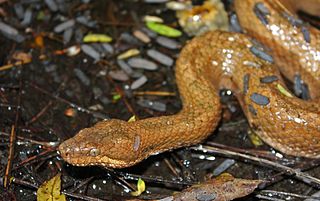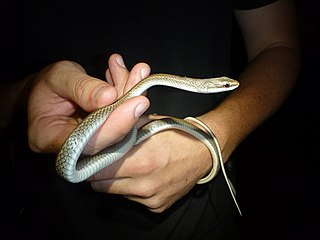
Sphaerodactylus is a genus of geckos from the Americas that are distinguished from other Gekkota by their small size, by their round, rather than vertical, eye pupils, and by each digit terminating in a single, round adhesive pad or scale, from which their name is derived. All species in this genus are rather small, but two species, S. ariasae and S. parthenopion, are tiny, and – with a snout-vent length of about 1.6 cm (0.63 in) – the smallest reptiles in the world.

Leiocephalidae, also known as the curlytail lizards or curly-tailed lizards, is a family of iguanian lizards restricted to the West Indies. One of the defining features of these lizards is that their tail often curls over. They were previously regarded as members of the subfamily Leiocephalinae within the family Tropiduridae. There are presently 29 known species, all in the genus Leiocephalus.

Tropidoclonion is a genus of snake in the subfamily Natricinae of the family Colubridae. The genus is monotypic, containing the sole species Tropidoclonion lineatum, commonly known as the lined snake. The species is endemic to North America.

Hypsiglena jani, commonly known as the Texas night snake or the Chihuahuan night snake, is a small species of mildly venomous snake in the family Colubridae. The species is native to the southwestern United States and adjacent northeastern Mexico.

Tropidophis, common name wood snakes or West Indian wood snakes, is a genus of dwarf boas endemic to the West Indies and South America. Currently, either 17 or 33 species are recognized, depending on the authority.

The Leeward Island racer is a species of snake in the family Colubridae. The species is found in Anguilla, Saint Barthélemy, and is probably extirpated from Sint Maarten.
The Saint Croix racer is a possibly extinct species of snake in the family Colubridae. The species is endemic to the island of Saint Croix, United States Virgin Islands.
The Barbados racer, also commonly known as the tan ground snake, was a species of colubrid snake that was endemic to Barbados. It is now extinct.

Julia's ground snake is a species of snake in the family Colubridae. The species is found in the Caribbean, on the Lesser Antilles islands of Dominica and Guadeloupe.

Barbour's tropical racer is a species of snake in the family Colubridae. The species is endemic to the Caribbean.
Shaw's dark ground snake, also known commonly as Shaw's black-backed snake, and in Spanish as candelilla, guarda caminos, and reinita cazadora, is a species of snake in the family Colubridae. The species is native to northern South America.

Chilabothrus striatus, the Hispaniolan boa, is a species of snake in the family Boidae. The species is endemic to Hispaniola. The species is regularly found in the international pet trade.
Arrhyton is a genus of New World snakes, commonly known as island racers or racerlets, in the family Colubridae. The genus contains 9 described species.

Clelia clelia, commonly known as the black mussurana or windward cribo, is a species of snake in the family Colubridae. The species is native to the New World.

Uromacer catesbyi, also known commonly as the blunt-headed Hispaniolan vinesnake and Catesby's pointed snake, is a species of snake in the family Colubridae. The species is endemic to the island of Hispaniola.
Uromacer frenatus is a species of snake in the family Colubridae. The species is endemic to Hispaniola in the West Indies.

Ialtris is a genus of snakes in the subfamily Dipsadinae of the family Colubridae. The genus is endemic to the island of Hispaniola.

Sphaerodactylus richardsonii, also known commonly as Richardson's least gecko or the northern Jamaica banded sphaero, is a small species of lizard in the family Sphaerodactylidae. The species is endemic to Jamaica.

Sphaerodactylus torrei, also known commonly as Barbour's least gecko or the Cuban broad-banded geckolet, is a small species of lizard in the family Sphaerodactylidae. The species is endemic to Cuba.
Anolis bremeri, also known commonly as the Cuban variegated anole and the Herradura anole, is a species of lizard in the family Dactyloidae. The species is endemic to Cuba. Two subspecies are recognized.














